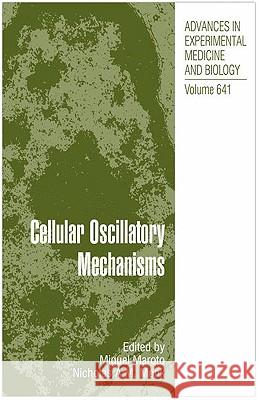Cellular Oscillatory Mechanisms » książka



Cellular Oscillatory Mechanisms
ISBN-13: 9780387097930 / Angielski / Twarda / 2008 / 153 str.
Cellular Oscillatory Mechanisms
ISBN-13: 9780387097930 / Angielski / Twarda / 2008 / 153 str.
(netto: 576,41 VAT: 5%)
Najniższa cena z 30 dni: 578,30
ok. 22 dni roboczych
Dostawa w 2026 r.
Darmowa dostawa!
The papers in this text provide an introduction to a range of both well known and less familiar cellular oscillations, and serves to illustrate the striking richness of cellular dynamics.
Wydanie ilustrowane
1. CALCIUM OSCILLATIONS; Ruediger Thul, Tomas C. Bellamy, H. Llewelyn Roderick, Martin D. Bootman, and Stephen Coombes Abstract Introduction Modelling Ca2+ Dynamics Mechanistic Models Homogenous Cell Models Threshold Models Stochastic Modelling Concluding Remarks 2. OSCILLATIONS BY THE p53-Mdm2 FEEDBACK LOOP; Galit Lahav Abstract Introduction The p53-Mdm2 Negative Feedback Loop Oscillations of p53 and Mdm2 The Mechanism of p53-Mdm2 Oscillations Variability in the Response of Individual Cells The Potential Function of p53 Oscillations Conclusion and Key Questions in the Field 3. CAMP OSCILLATIONS DURING AGGREGATION OF DICTYOSTELIUM; William F. Loomis Abstract Introduction Proposed cAMP Oscillatory Circuit Periodic Motility Discussion 4. MIN OSCILLATION IN BACTERIA; Joe Lutkenhaus Abstract Introduction Z Ring The Min System The Oscillation Biochemistry of Min Proteins Models Conclusions 5. DEVELOPMENT ON TIME; Isabel Palmeirim, Sofia Rodrigues, J. Kim Dale and Miguel Maroto Abstract Somitogenesis Is a Strict Time-Controlled Embryonic Process Time Control during Somite Formation: The Segmentation Clock The Genetic Complexity Underlying the Segmentation Clock The Clock and Wavefront Model Temporal vs Positional Information Conclusions 6. OSCILLATORY EXPRESSION OF HES FAMILY TRANSCRIPTION FACTORS: INSIGHTS FROM MATHEMATICAL MODELLING; Hiroshi Momiji and Nicholas A.M. Monk Abstract Delay-Driven Oscillations in Cellular Signaling Systems Hes1 as a Cellular Oscillator Mathematical Modelling of the Hes1 Oscillator Properties of Delay-Driven Oscillations Extended Models of Hes1 Regulation Spatio-Temporal Coordination of Oscillatory Dynamics Discussion 7. REVERSE ENGINEERING MODELS OF CELL CYCLE REGULATION; Attila Csiksz-Nagy, Bla Novk and John JTyson Abstract Bottom-Up Modeling and Reverse Engineering Physiology of the Cell Cycle Three Cell Cycle States and Three Cell Cycle Transitions Cell Cycle Transitions and Bifurcation Points Reverse Engineering the Molecular Regulatory Network The Complete Bifurcation Diagram Cell Cycles and Limit Cycles Conclusion 8. MITOCHONDRIAL OSCILLATIONS IN PHYSIOLOGY AND PATHOPHYSIOLOGY; Miguel A. Aon, Sonia Cortassa and Brian ORourke Abstract Introduction The Mitochondrial Oscillator of Heart Cells: The Pathophysiological Domain The Theoretical Approach The Mitochondrial Oscillator in the Physiological Domain Spatial Aspects: ROS and Mitochondrial Criticality From Mitochondrial Dynamics to Whole Heart Arrhythmias Conclusions 9. RESPIRATORY OSCILLATIONS IN YEASTS; David Lloyd Abstract Introduction Minute-Long Oscillations in S. cerevisiae Ultradian (t 30-50min) Oscillations in Synchronous Cultures of Yeasts Schizosaccharomyces pombe Candida utilis Saccharomyces cerevisiae: Self Synchronized Continuous Culture Mitochondrial Respiratory Dynamics in Vivo During Growth Oxidative Stress and Signalling by ROS Circadian Oscillations in Yeasts Other Oscillations Functions of Oscillations 10. STOCHASTIC PHASE OSCILLATOR MODELS FOR CIRCADIAN CLOCKS; Jacques Rougemont and Felix Naef Background Mathematics of Phase Models Theory vs. Data Conclusion
MIGUEL MAROTO, PhD, is a MRC Career Development Fellow and Lecturer at the University of Dundee, UK. He received his PhD in Biochemistry and Molecular Biology from the Department of Biochemistry of the Universidad Autonoma of Madrid, Spain. His research interests include investigating the biochemical basis of different signalling mechanisms implicated in the acquisition of specific cell fates during vertebrate development. During the last years he has been implicated in the analysis of the mechanism of the molecular clock involved in the control of the process of somitogenesis.
NICK MONK, PhD, is an Associate Professor and Reader in Applied Mathematics at the University of Nottingham, UK. Having received his Ph.D. in theoretical physics from the University of London, his research changed focus to centre on the mathematical and computational modelling of biological systems. Particular areas of interest include pattern formation, developmental biology, complex network dynamics and mechanisms of intercellular signalling.
1997-2025 DolnySlask.com Agencja Internetowa
KrainaKsiazek.PL - Księgarnia Internetowa









